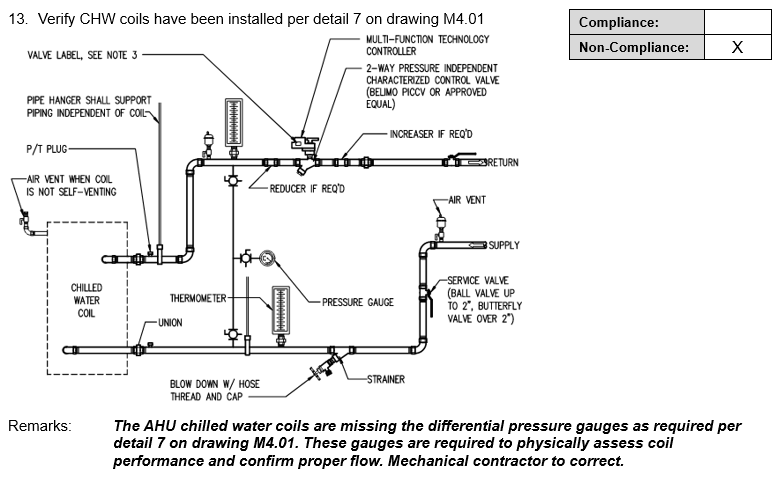For any project with commissioning, the functional testing portion of the commissioning process is arguably one of the most important and rigorous activities. Unfortunately, if the commissioning process is not properly organized and executed, the functional testing portion of the project may leave the commissioning team with an overwhelming laundry list of issues. However, there are some key steps to the process that if followed can result in fewer issues and quicker project closeout. Over the years I’ve reflected back on my projects and in this article highlighted some of those important steps.
First, the best time to identify and address an issue is now! Too often, the commissioning agent (CxA) is hired late in the project, but incorporating the CxA in the design and submittal review process is one of the best ways to identify and resolve issues before they become an issue. If coordination issues slip past, the final review of the system is typically done during the functional performance testsheet development process. At this point, the CxA should have access to all RFIs, submittals and design changes. If clear design intent or sequences still can’t be determined, a commissioning meeting should be scheduled ASAP to discuss, clarify and resolve these issues before functional testing begins.
Next, the commissioning plan must be clearly outlined, presented to, and followed by all commissioning team members. The Owner, Design Team, Construction Manager, Subcontractors, and any other members must clearly understand the commissioning process and what needs to happen before functional testing. Before equipment start-ups even begin, the commissioning team should understand what pre-testing documents must be submitted, who’s responsible for producing the documents and how the documentation will be gathered in a timely manner. Establishing a clear workflow early on helps prevent surprises and can ensure each member is held accountable for their deliverables and helps facilitate a smoother process when the project turnover approaches and schedules get hectic. The CxA is often pressured to test systems early due to tight schedules, however, ensuring all parties have fully completed their work and pretested their systems is an important aspect. In my kick-off meetings, I like to mention that all systems should be 100% ready for turnover to the Owner. The CxA is simply the last step before the Owner receives them!
As the project nears functional testing, the CxA must ensure an accurate and transparent testing schedule is submitted and understood by all. Items such as the number of CxA engineers onsite, required subcontractor assistance and equipment that is to be tested each day should be clearly defined. The Owner should also be heavily involved in the testing schedule to confirm the testing does not interfere with their day-to-day operations. For larger system tests such as emergency generators and smoke pressurization tests, multiple parties may need to be coordinated. The length of planning and scheduling these tests must be taken into account to ensure timely execution.
After the functional testing is completed, the ball is then in the CxA’s court to track, review and resolve issues. One of the most important aspects that can lead to quick retesting timelines is the language used to document issues. At Sustainable Engineering Solutions, our teams are trained to document issues with the following in mind:

- What is the issue, and why is it an issue?
- Where in the project documents is the requirement outlined?
- Are there any recommendations?
- Who’s responsible for addressing the issue?
By ensuring all four of these questions are answered when writing issues, there is minimal back and forth and issues are easily addressed by the team member they are assigned to.
Even when all the above steps are properly taken, the issue resolution timeline can still drag on. It is easy for the team to “relax” after the testing is complete, but this is the time for teams to push. Immediately after testing, the commissioning team should have an assigned person from each trade responsible for addressing their issues. The CxA should also take an active role in scheduling frequent commissioning meetings to track issue progress and ensure all parties are actively working to resolve issues. This is also when the design team should be brought back into the project and have an active role. If there are design-related issues, these should be made a priority to review and resolve. If the design issues result in additional work, it’s important that these issues are addressed in a timely manner to prevent further project delays.
Lastly, once all items are addressed the CxA must re-test items to confirm correction. By physically returning to the project site to retest issues with subcontractors, the CxA is validating that issues are corrected without further adjustments being needed and that the corrective action addresses the current facility requirements.
Overall, the functional testing and issue close out process is arguably one of the most important parts of the commissioning process. When the commissioning agent is equipped with the proper scope of services, the commissioning plan is followed by all and the team is prepared to attack the issues log, everyone wins.

About the Author:
Brian Messerschmidt is a Project Manager at Sustainable Engineering Solutions. He has managed numerous Commissioning and Retro-Commissioning projects throughout Connecticut and Massachusetts. Brian earned his B.S. in Mechanical Engineering from Central Connecticut State University. He is a registered Professional Engineer in the State of Connecticut and a Certified Energy Manager.
